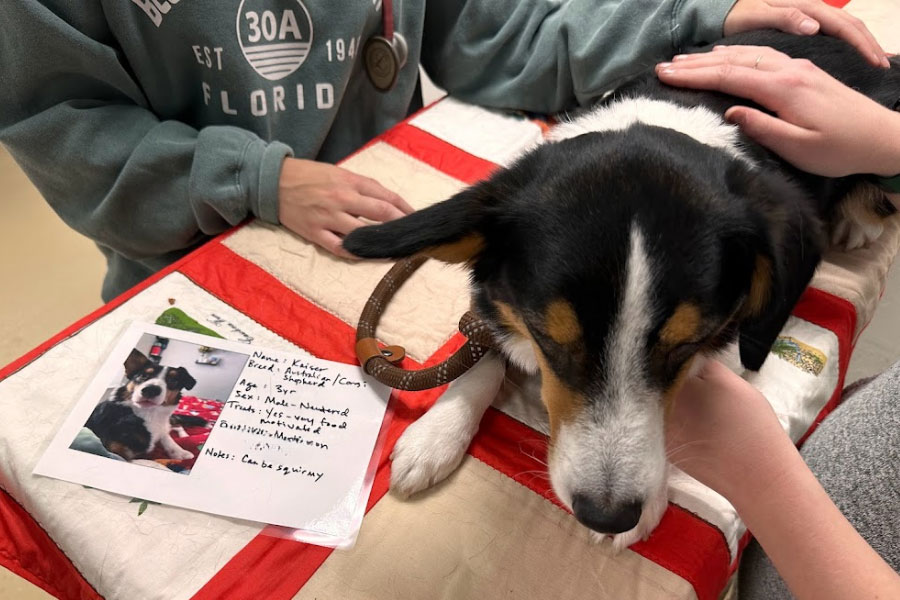
In a clinical skills classroom at the College of Veterinary Medicine (CVM), small groups of first- and second-year veterinary students gather near exam tables. They are about to meet today’s “Pup Professors”—a corps of volunteer dogs playing the role of patients for the hour.
The participating dogs, typically pets of CVM faculty, staff, or students, receive nose-to-tail physical exams by students practicing their skills under the guidance of clinical faculty, residents, and interns. Students prepare for this experience by attending lectures on dog handling and behavior, studying the physiology and anatomy of dogs, and reviewing videos demonstrating how to complete a physical exam.
This is the first formal opportunity for students to practice the nose-to-tail physical in a clinical skills learning center with a live animal. Among them is first-year student Sophie Ramirez, who, on this day, is eager to put the skills she has learned in the classroom to practice.
“I believe the pup professors will help prepare me for future clinical work,” she says. “It helps inspire confidence and allows for practice, and we all know the adage that practice makes perfect.”
Nearby tables contain laminated checklists of physical exam elements to guide Ramirez and her peers. One visual aid demonstrates how to determine the body condition score and muscle condition score of a dog by comparing its build to a series of photos showing an ideal weight.
Instructor Steve Friedenberg, an associate professor in the Department of Veterinary Clinical Sciences (VCS), begins by reviewing techniques for conducting the nose-to-tail exam. He asks his student group what health information they observe about the dog from a distance, such as if the dog seems relaxed, fearful, or anxious.
As their pup professor nears the group, Friedenberg encourages students to observe the dog’s gait and symmetry. After meeting and greeting today’s patient and hearing additional tips from Friedenberg, students take turns practicing physical exams.
Across the room, another instructor, Caitlin Yung, a veterinary oncology resident, demonstrates how to examine a dog's mouth to her students. Not long ago, Yung was in their shoes and learning these skills. She says the value of students working with volunteer dogs in this setting is “an opportunity to practice these skills in a risk-free environment in order to build student confidence and prepare them for the real thing.”
The physical exam is an essential skill when doctor of veterinary medicine students join the veterinary workforce. The American Association of Veterinary Medical Colleges lists “gathering a history, performing an examination, and creating a prioritized differential diagnosis list” as one of the foundations of its Competency-Based Veterinary Education program.
“Perhaps the most critical clinical skill for all veterinary clinicians is learning how to complete a thorough physical exam the same way each time and knowing what a normal exam finding is and what is an abnormal finding,” says Susan Spence, an assistant professor in VCS.
While it’s possible to teach some skills with simulators and models, these methods don’t give students practice in managing various behaviors encountered when examining a real dog accompanied by its owner. Working with the Pup Professors program volunteers offer students an opportunity to build confidence and competency in their skills and lay the foundation for providing quality care to their future patients.
This story was adapted from the U of M College of Veterinary Medicine. See the original story.




